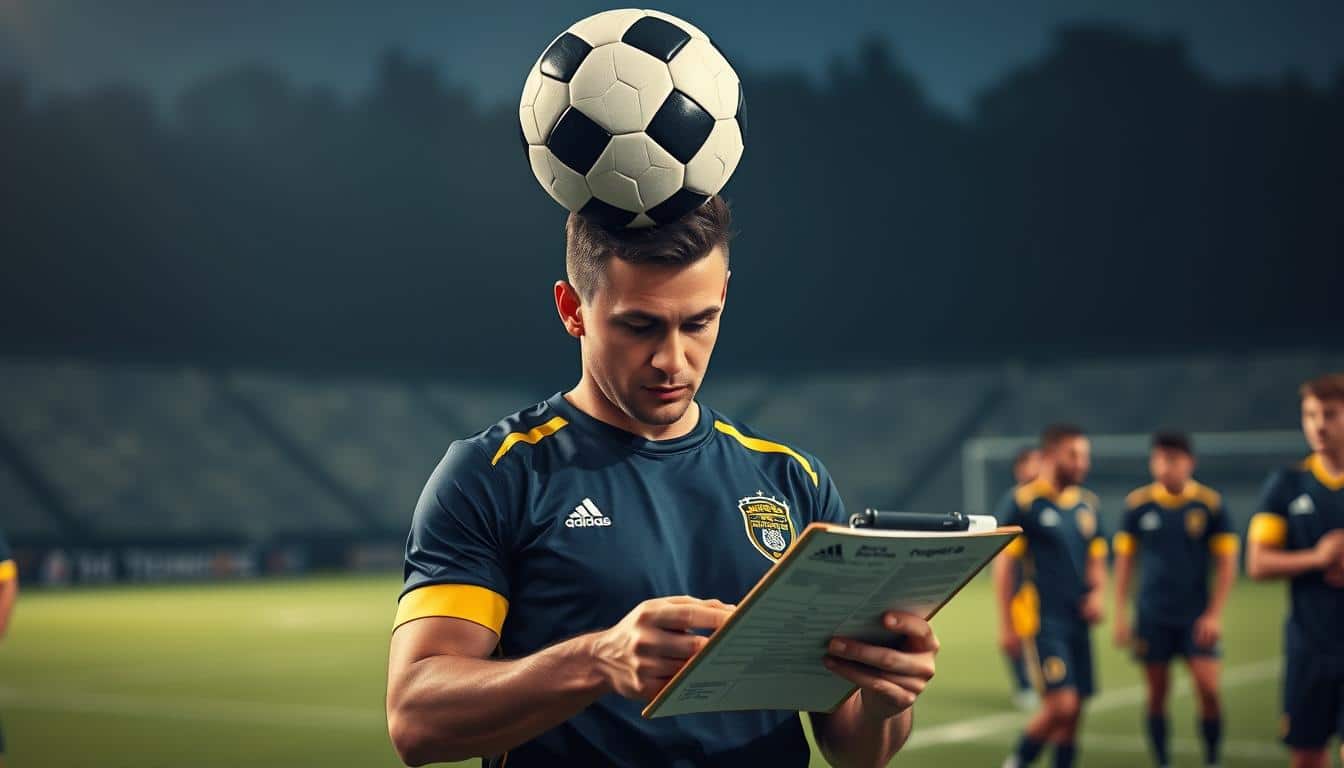Responsibilities of a Soccer Team Captain

Ever wondered what separates a good team leader from a great one? Being a soccer captain isn’t just about wearing an armband—it’s about steering your squad through challenges while keeping morale high. Whether you’re new to the role or looking to improve, understanding these duties can make or break your team’s success.
Captains act as the glue between coaches and players. They analyze strategies mid-game, adapt to opponents’ moves, and inspire teammates when pressure mounts. But leadership doesn’t stop at the final whistle. From resolving conflicts to setting examples during practice, every decision shapes the group’s dynamics.
Key Takeaways
- A captain’s influence extends far beyond symbolic gestures like wearing an armband.
- Effective leaders balance strategic thinking with emotional support for teammates.
- Game-time decisions often require quick adaptation to shifting circumstances.
- Daily interactions off the field are just as critical as in-game leadership.
- Shared leadership models still rely on the skipper’s central coordinating role.
Overview of the Captain’s Role
Behind every successful squad is a leader mastering multiple roles. You’re not just another player – you’re a strategist, motivator, and bridge between peers and staff. Your actions set the tone during practices, games, and even off-field moments.
Defining the Captain’s Duties
Your day-to-day tasks blend on-field performance with off-field guidance. You decode coaching strategies for teammates while addressing their concerns. Juggling communication, decision-making, and personal play requires sharp focus and adaptability.
The Impact on Team Dynamics
Great leaders recognize that each teammate thrives under different conditions. Some need pep talks; others prefer quiet encouragement. By tailoring your approach, you build trust and unity that translates to cohesive gameplay. This awareness often separates good groups from championship-caliber units.
Matchday Duties and Pre-Game Tasks
Game days demand precision and poise from leaders. Your role shifts into high gear long before the opening whistle. Clear communication and decisive actions set the stage for success.
Coin Toss and Referee Roles
You’ll meet with the referee first thing. This chat clarifies rules and confirms everyone’s on the same page. Ask questions now to avoid confusion later.
The coin toss isn’t just tradition—it’s your first strategic move. Winning lets you pick field direction or initial possession. Consider weather and sunlight when choosing sides.
During play, officials will address you about any issues. Stay calm when discussing calls. Your composed response keeps tensions low and focus high.
Pre-match talks boost morale. Highlight strengths from recent practices. At halftime, adjust tactics based on what’s working. Keep messages concise but energizing.
These routines cement your authority. From the initial handshake to final instructions, every action builds trust. Consistent leadership keeps squads united through ninety intense minutes.
Leading the Team on the Field
The true test of leadership unfolds in real-time during high-stakes moments. You balance split-second choices with emotional awareness, adapting your approach to match the game’s rhythm. Whether directing formations or boosting morale, your actions directly shape outcomes.
In-Game Decision Making
Quick thinking separates average leaders from game-changers. You assess threats like defensive gaps or tired players, then adjust tactics instantly. For example, shifting to a counterattack strategy when opponents overcommit forward.
Trust your instincts but stay open to input. A glance at your midfield organizer might reveal unseen opportunities. Effective choices often blend personal judgment with collective awareness.
Motivating Teammates
Energy levels fluctuate during matches—your role is to stabilize them. Some players thrive on fiery pep talks; others need calm reassurance. Match your tone to the situation:
- Early setbacks: Focus on resetting mentally (“Next play mentality”)
- Critical moments: Highlight preparation (“We’ve trained for this”)
- Fatigue phases: Use humor to lighten pressure (“They’re more tired than us!”)
Confidence spreads when you model composure. Celebrate small wins loudly—a perfect tackle or smart pass—to reinforce positive habits.
Effective Communication as a Captain
What separates a respected leader from just another voice on the field? Your ability to deliver clear, actionable messages determines how well your group responds in critical moments. Mastering this skill means knowing when to speak, what to emphasize, and how to simplify complex ideas.
Talking With the Referee
Approach officials with calm professionalism. Instead of arguing calls, ask clarifying questions like, “Could you explain that offside decision?” This builds mutual respect while gathering tactical insights.
Keep exchanges brief and solution-focused. For example: “We’re noticing sliding tackles near the box – should we adjust?” Referees appreciate captains who prioritize game flow over complaints.
Clear Messages to Teammates
Apply the KISS principle (Keep It Simple, Stupid) during play. Replace long instructions with quick cues:
- Use hand signals for common plays
- Shout positional keywords (“Shift left!”)
- Assign numbers to frequent strategies
Between halves, bridge gaps between coaches and players. Translate technical feedback into digestible steps: “Coach wants tighter marking – focus on staying goal-side.”
Silence can be powerful too. Sometimes, a pat on the back or pointed eye contact communicates more than words. Read the room – if tensions rise, simplify your language and lower your tone.
Managing Pressure and Staying Focused
The toughest battles a leader faces aren’t on the field—they’re in the mind. Staying sharp when stakes are high separates those who crack under stress from those who thrive. Your ability to keep a cool head directly impacts every pass, play, and pivotal moment.
Staying Calm Under Stress
Breath control is your secret weapon. Inhale deeply through your nose for four counts, hold it, then exhale slowly. This simple trick lowers heart rates and clears mental fog during critical plays.
Visualization helps too. Before matches, rehearse high-pressure scenarios in your mind. Picture yourself making smart choices despite crowd noise or opponent taunts. This mental prep builds resilience when real challenges hit.
Losing your temper has consequences. When tensions rise, opponents see emotional outbursts as weaknesses. They’ll exploit this by pushing harder, knowing your focus has slipped. Your squad needs you locked in—not distracted by frustration.
Try the “5-second reset” after bad calls or mistakes. Count backward from five while scanning the field. This forces your brain to analyze options instead of reacting impulsively. Support teammates using this method too—it keeps everyone at peak performance levels.
Guiding Training Sessions and Practice Drills
Your influence as a leader shines brightest when teammates follow your lead without hesitation. Directing practice activities builds trust while sharpening essential skills. This isn’t about replacing coaches—it’s about creating shared ownership of growth.
Conducting Warm-Ups and Cool Downs
Start by mastering basic routines. Work with your coach to learn proper stretches and dynamic movements. For example, lead a 10-minute warm-up focusing on leg swings and light jogging. Keep instructions clear: “We’ll do three sets of high knees—follow my pace!”
Effective cool-downs prevent injuries and reset focus. Guide players through static stretches while discussing practice highlights. Ask questions like, “What worked well today?” to encourage reflection.
| Focus Area | Effective Approach | Ineffective Approach |
|---|---|---|
| Duration | 12-15 minute structured routine | Unplanned, inconsistent timing |
| Intensity | Gradual increase in movement speed | Starting at full speed immediately |
| Engagement | Demonstrating exercises first | Only verbal instructions |
Rotate leadership roles during drills to build confidence. If running passing exercises, let others explain key points. This reinforces their understanding while giving you time to observe.
Always verify techniques with staff before leading activities. A quick pre-practice chat ensures everyone’s aligned. When done right, these moments cement your role as both peer and guide.
Demonstrating Leadership Through Actions
True authority comes from what you do, not just what you say. Your daily habits and reactions become the blueprint others follow—both in drills and decisive moments. This silent teaching often impacts group culture more than any speech.
Leading by Example
Arrive 15 minutes early to every session. Be the first to collect cones after practice. These small choices show commitment louder than any pep talk. When others see you sweating through extra sprints, they’ll push harder too.
Support looks different in action. Instead of generic praise, try:
- High-fiving a teammate who nails a difficult drill
- Offering to stay late with someone struggling on free kicks
- Publicly acknowledging improvements during film review
| Situation | Effective Approach | Poor Approach |
|---|---|---|
| Missed goal opportunity | Clap loudly: “Next one’s yours!” | Rolling eyes or sighing |
| Post-practice cleanup | Carrying equipment without being asked | Leaving immediately after drills |
| New play confusion | Demonstrating movements slowly | “Figure it out yourself” attitude |
Handle mistakes calmly. When you misplace a pass, immediately track back to defend. This teaches resilience better than a lecture. Your consistency in effort—even during boring drills—proves every moment matters.
Key Soccer team captain responsibilities on and off the field
Leadership doesn’t stop when the whistle blows—it’s a full-time commitment shaping every interaction. Your role stretches far beyond the pitch, blending visible actions with behind-the-scenes efforts that define your group’s identity.

Balancing On-Field and Off-Field Duties
Juggling match performance with organizational tasks requires smart planning. Start by syncing calendars with your coach weekly. Confirm practice times, track player availability, and delegate simple jobs like gear management. This keeps everyone focused on priorities.
Public appearances matter too. When speaking at club events or interviews, highlight collective values over personal achievements. Use phrases like “Our group believes…” to reinforce unity. Remember—you’re the face others associate with your squad’s culture.
| On-Field Focus | Off-Field Priority |
|---|---|
| Tactical adjustments | Social media updates |
| In-game motivation | Community outreach |
| Positional communication | Player availability tracking |
Build bonds through casual gatherings. Organize monthly team meals or skill-sharing sessions. These moments strengthen trust that translates to better coordination during matches.
Protect your schedule ruthlessly. Block specific times for film review, individual check-ins, and personal training. Apps like Google Calendar help balance these demands without burnout. Your ability to model this balance inspires others to manage their commitments better too.
Final Thoughts on Leading Your Team
What legacy will your leadership leave? Legends like Ramos and Puyol didn’t earn respect through armbands alone—they built trust by prioritizing their group’s needs above personal glory. Their careers show that true influence grows through consistent action, not temporary gestures.
Great leaders turn setbacks into stepping stones. A tough loss becomes a chance to unite players. A locker room conflict? An opportunity to demonstrate calm problem-solving. Every challenge lets you prove why you’re the guide your peers rely on.
Your job blends visible efforts with quiet support. Celebrate wins loudly, but also check in with struggling teammates privately. Balance high standards with empathy—push your club forward while ensuring no one feels left behind.
Remember: leadership isn’t about perfection. It’s about showing up season after season, learning from each game, and making decisions that lift everyone’s performance. Start small—master one skill like active listening or tactical feedback—then expand your range as experience grows.
The path from player to respected leader takes time. But with every practice you organize, every tough call you make, and every teammate you uplift, you’re writing a legacy that outlasts any trophy.
